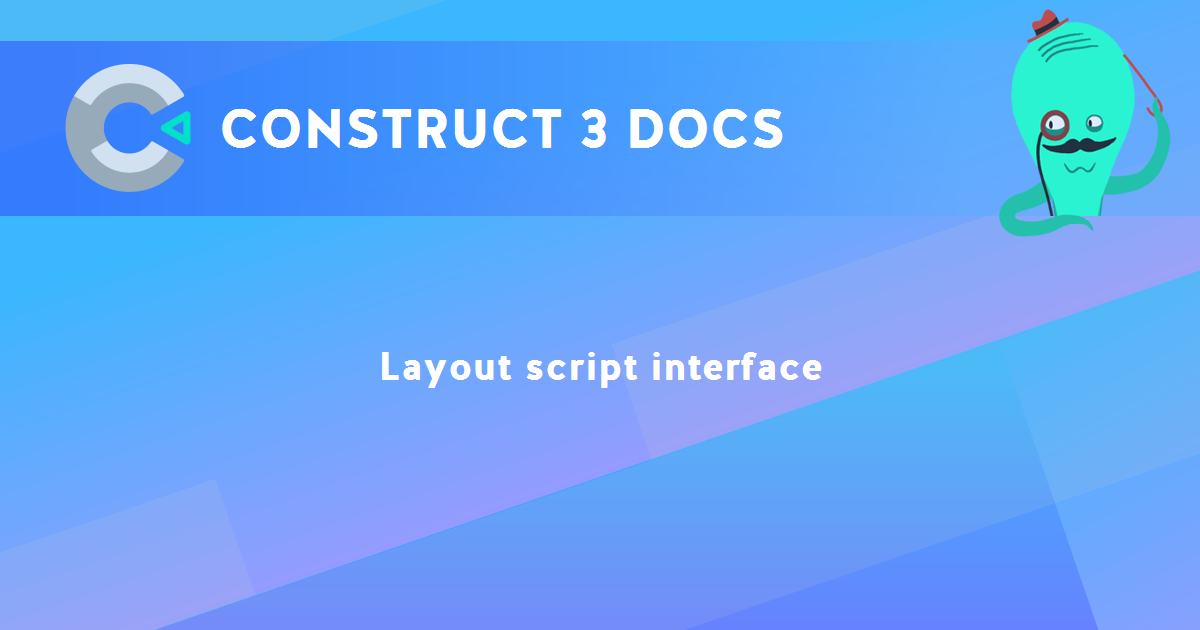Layout script interface
The ILayout script interface represents a layout in the project.
Getting an ILayout
The ILayout interface is typically accessed via the IRuntime layout property, e.g. runtime.layout. This represents the current running layout. Other layouts can be accessed via the IRuntime methods getLayout() and getAllLayouts().
Layout events
The following events can be listened for using the addEventListener method.
- "beforelayoutstart"
- "afterlayoutstart"
- Fired when the layout starts.
"beforelayoutstart" fires just before On start of layout, and "afterlayoutstart" fires just after. In both events, all instances on the layout are created and available to modify.
- "beforelayoutend"
- "afterlayoutend"
- Fired when the layout ends due to changing to another layout.
"beforelayoutend" fires just before On end of layout, and "afterlayoutend" fires just after. In both events, all instances on the layout are still available, but all non-global instances are destroyed immediately after the "afterlayoutend" event.
Layout APIs
- name
- A read-only string of the layout name.
- index
- A read-only number of the zero-based index of the layout in the order it appears in the Project Bar.
- addEventListener(eventName, callback)
- removeEventListener(eventName, callback)
- Add or remove a callback function for an event. See Layout events above for the available events.
- width
- height
- setSize(width, height)
- getSize()
- Set or get the size of the layout. The methods allow setting and getting both values at the same time.
- scrollX
- scrollY
- scrollTo(x, y)
- getScrollPosition()
- Set or get the scroll position in layout co-ordinates.
scrollTo() is a shorthand for setting both scrollX and scrollY, and getScrollPosition() returns both scroll co-ordinates at the same time.
- scale
- Set or get the layout scale, with
1 being the default scale, 2 being 2x scale, etc. This scales all the layers in the layout, taking in to account their scale rate property.
- angle
- Set the layout angle in radians. This rotates all the layers in the layout.
- projection
- Set or get a string specifying the current layout projection, which must be one of
"perspective" or "orthographic". For more details see Projection in Layout Properties.
- setVanishingPoint(vpX, vpY)
- getVanishingPoint()
- Set or get the Vanishing point layout property, with each component in the range 0-1. The getter returns an array with two elements in the form
[vpX, vpY].
- effects
- An array of IEffectInstance representing the effect parameters of the effects on this layout.
Layer APIs
These APIs relate to the set of layers on the layout.
- getLayer(layerNameOrIndex)
- Get an ILayer interface for a layer on the layout, by a case-insensitive string of its name or its zero-based index. When passing a number, an out-of-range number is clamped to the valid range and the nearest layer returned. When passing a string, if no layer with the given name is found, the method returns
null.
- *allLayers()
- Iterates ILayer interfaces representing all the layers on the layout, in increasing Z order.
- getAllLayers()
- Return an array of ILayer interfaces representing all the layers on the layout, in increasing Z order.
- addLayer(layerName, insertBy, where)
- Create a new layer and insert it to the layer tree at runtime (also known as a dynamic layer).
layerName is a string of the name to use for the added layer, which must be different to all existing layers already added, including other dynamic layers. insertBy is an ILayer of another layer to insert the new layer relative to. where specifies where to insert the new layer relative to the insertBy layer, which may be one of the following strings:
"above" or "below": insert adjacent to the insertBy layer, above or below it in Z order.
"top-sublayer" or "bottom-sublayer": insert as a sub-layer of the insertBy, at the top or bottom of its existing sub-layers. insertBy may also be null, in which case the new layer is added at the top or bottom at the root level of the layer tree.
- moveLayer(layerToMove, insertBy, where)
- Remove and re-insert a layer to a new location in the layer tree. This works similarly to
addLayer(), except layerToMove refers to an ILayer that already exists; otherwise the insertBy and where parameters are used in the same way.
- removeLayer(layer)
- Remove a given ILayer from the layer tree. This also removes any sub-layers of the removed layer, and all objects on the layer or any of its sub-layers will be destroyed. A layout must have at least one layer, so the last top-level layer cannot be removed.
- removeAllDynamicLayers()
- Removes all layers added using the
addLayer() method, leaving only the layers added in the editor. All objects on the removed layers will be destroyed. This can be useful to reset the state of dynamic layers.
Construct 3 Manual
Construct.net
2019-06-03
2023-09-13

You are here:
Search this manual:
This manual entry was last updated on 13 Sep, 2023 at 13:22